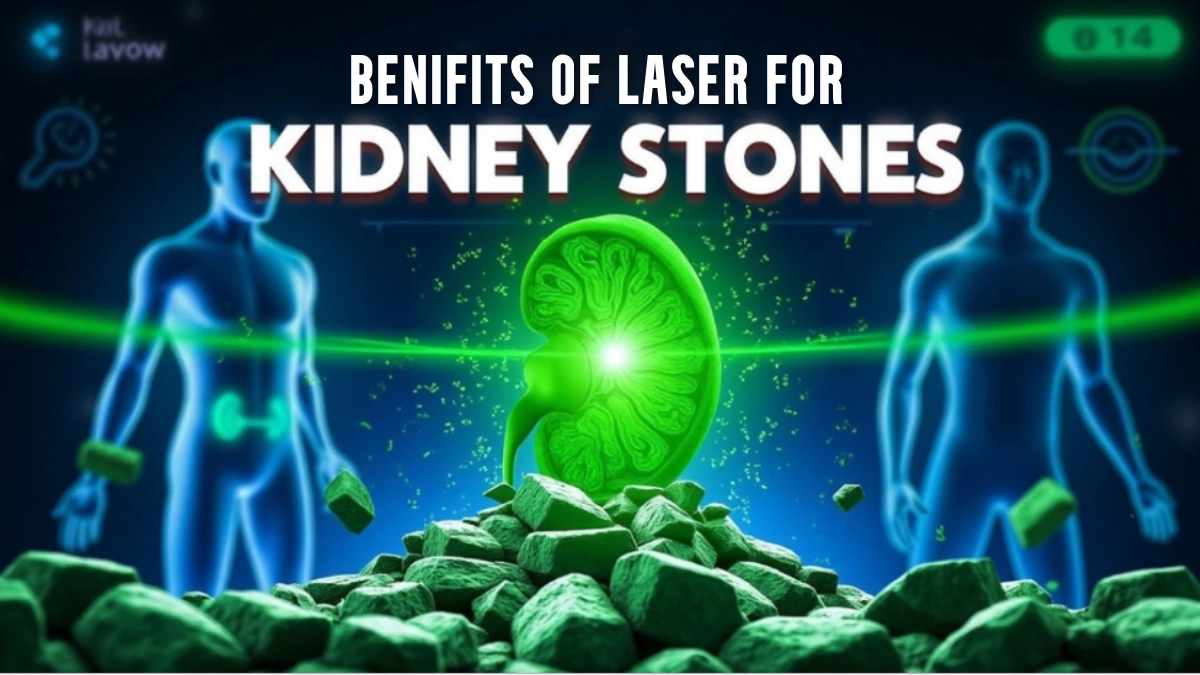When kidney stones strike, the pain can be absolutely debilitating. Many patients describe it as worse than childbirth. If you’re reading this, chances are you or someone you care about is facing this painful reality. The good news? Modern laser surgery has transformed kidney stone treatment from a major ordeal into a precise, minimally invasive procedure that gets you back on your feet faster than ever before.
Gone are the days when kidney stone removal meant weeks of recovery and significant surgical trauma. Today’s laser lithotripsy techniques offer hope, precision, and remarkably quick healing times. But what exactly happens during laser surgery for kidney stones, and is it right for your situation?
Understanding Kidney Stones: The Enemy We’re Fighting
Before diving into laser treatment, it’s crucial to understand what we’re dealing with. Kidney stones form when minerals and salts crystallize in your kidneys, creating hard deposits that can range from tiny grains to golf ball-sized masses. The most common types include calcium oxalate stones (about 80% of cases), uric acid stones, struvite stones, and the rare cystine stones.
What makes stones so problematic isn’t just their presence, it’s their journey. When these crystalline formations attempt to travel through your urinary tract, they can cause excruciating pain, bleeding, infection, and potentially serious complications if left untreated.
The Laser Revolution: How Modern Technology Changed Everything
Laser surgery for kidney stones, technically called laser lithotripsy, represents one of medicine’s most elegant solutions to a painful problem. The procedure uses focused laser energy to fragment stones into tiny pieces that can naturally pass through your urinary system.
The most commonly used laser is the holmium:YAG laser, which delivers precise pulses of energy at a wavelength that’s perfectly absorbed by both stones and water. This selective absorption means the laser can pulverize stones while minimally affecting surrounding healthy tissue, a remarkable feat of medical engineering.
How Laser Lithotripsy Actually Works
During the procedure, your urologist inserts a thin, flexible scope (ureteroscope) through your urethra and bladder, navigating up to where the stone is lodged. Think of it as an incredibly sophisticated plumbing inspection, except instead of just looking, the surgeon can take action.
Once the stone is visualized, a laser fiber thinner than a human hair is threaded through the scope. The laser then delivers controlled bursts of energy, systematically breaking the stone into fragments small enough to pass naturally or be removed with tiny baskets.
Types of Laser Procedures: Finding Your Best Option
Ureteroscopic Laser Lithotripsy (URS)
This is the most common approach for stones in the ureter or lower portion of the kidney. The entire procedure happens through your natural urinary tract, no incisions required. It’s particularly effective for stones under 2 centimeters and boasts success rates exceeding 95% for appropriately selected cases.
Percutaneous Nephrolithotomy (PCNL) with Laser
For larger kidney stones (typically over 2 centimeters), surgeons may create a small incision in your back to access the kidney directly. While more invasive than URS, it’s still far less traumatic than traditional open surgery and allows for treatment of complex stone burdens that would be impossible to address through the ureter.
Flexible Ureteroscopy with Laser
This advanced technique allows surgeons to navigate into all areas of the kidney using an incredibly flexible scope. It’s revolutionized treatment for stones in hard-to-reach locations and multiple stones throughout the kidney collecting system.
The Procedure Day: What to Actually Expect
Most patients arrive at the surgical center in the morning, having fasted since midnight. The procedure typically takes 30 minutes to 2 hours, depending on stone size and complexity.
You’ll receive general anesthesia, so you’ll be completely comfortable throughout. Many patients are surprised to wake up with minimal discomfort, a stark contrast to the severe pain that brought them to treatment in the first place.
Here’s what happens step by step:
- Positioning and Preparation: You’re positioned to optimize access to your urinary tract
- Scope Insertion: The ureteroscope is carefully guided to the stone location
- Stone Visualization: High-definition cameras provide crystal-clear views of the target
- Laser Fragmentation: Precise laser pulses systematically break down the stone
- Fragment Removal: Larger pieces are removed with specialized baskets
- Stent Placement: A temporary stent may be placed to ensure proper drainage
Recovery: Getting Back to Your Life
One of laser surgery’s biggest advantages is the relatively quick recovery. Most patients go home the same day or after one overnight stay. You’ll likely experience some mild discomfort, increased urination frequency, and possibly some blood in your urine for a few days all completely normal parts of healing.
The key recovery milestones include:
- Days 1-3: Rest, increased fluid intake, and managing mild discomfort
- Week 1: Gradual return to light activities
- Weeks 2-4: Most patients return to full normal activities
- Follow-up: Imaging studies confirm successful stone clearance
Managing Post-Surgical Expectations
Don’t be alarmed if you experience some burning during urination or see small stone fragments in your urine over the following weeks. These are signs that the treatment is working. However, severe pain, fever, or inability to urinate requires immediate medical attention.
Success Rates and Effectiveness: The Numbers That Matter
Laser lithotripsy boasts impressive success rates, but these vary based on several factors:
- Stone size: Stones under 1 cm have success rates above 95%
- Stone location: Ureter stones respond better than complex kidney stones
- Stone composition: Harder stones like calcium oxalate may require multiple sessions
- Patient anatomy: Individual variations can affect access and success
Studies consistently show that laser treatment achieves stone-free rates of 85-95% for most patients, with minimal complications and high patient satisfaction scores.
Who Benefits Most from Laser Surgery?
Laser treatment isn’t universally appropriate, but it’s ideal for patients with:
- Stones between 5mm and 2cm in diameter
- Stones causing significant symptoms or complications
- Failed previous treatments like shock wave lithotripsy
- Occupations requiring quick return to work
- Preference for minimally invasive options
Patients with bleeding disorders, active infections, or certain anatomical abnormalities may need alternative approaches.
Potential Complications: Understanding the Risks
While laser surgery is remarkably safe, understanding potential complications helps you make informed decisions:
Minor complications (affecting 5-10% of patients):
- Temporary ureteral swelling
- Mild bleeding
- Urinary tract irritation
- Stone fragment retention
Rare but serious complications (less than 1%):
- Ureteral perforation
- Significant bleeding requiring transfusion
- Infection requiring hospitalization
- Ureteral stricture formation
Your surgeon will discuss your individual risk profile based on your specific situation.
Cost Considerations and Insurance Coverage
Laser kidney stone surgery typically costs between $8,000-$15,000, depending on complexity and geographic location. Most insurance plans cover the procedure when medically necessary, but it’s essential to verify coverage and understand your out-of-pocket responsibilities.
Many patients find that despite higher upfront costs compared to some alternatives, laser surgery’s high success rates and minimal recovery time make it cost-effective in the long run.
Preventing Future Stones: The Long-Term Strategy
Successful laser treatment is just the beginning. Without prevention strategies, up to 50% of patients develop new stones within 10 years. Your urologist will likely recommend:
- Increased fluid intake (aim for 2.5-3 liters daily)
- Dietary modifications based on stone analysis
- Medications to prevent specific stone types
- Regular monitoring with imaging and lab tests
Making Your Decision: Questions for Your Urologist
Before choosing laser surgery, discuss these crucial questions with your healthcare team:
- What’s my specific stone size, location, and composition?
- What’s my expected success rate with laser treatment?
- Are there alternative treatments I should consider?
- What’s your experience with laser procedures?
- What specific risks apply to my situation?
- What will my recovery timeline look like?
The Future of Laser Stone Treatment
Laser technology continues evolving rapidly. Newer laser systems offer even more precise energy delivery, shorter procedure times, and improved stone fragmentation efficiency. Some emerging technologies include:
- Pulse modulation techniques that optimize stone breakage
- Improved fiber optics for better maneuverability
- Real-time stone composition analysis during surgery
- Enhanced imaging systems for precise targeting
Taking the Next Step
If kidney stones are disrupting your life, laser surgery might offer the relief you’ve been seeking. The combination of high success rates, minimal invasiveness, and quick recovery makes it an attractive option for many patients.
Remember, every situation is unique. What works best for your friend or family member might not be optimal for your specific case. The key is working with an experienced urologist who can evaluate your individual circumstances and guide you toward the most appropriate treatment.
Don’t let kidney stone pain control your life any longer. Modern laser surgery has transformed an once-dreaded condition into a highly treatable problem with excellent outcomes for most patients.
Summary
Modern laser surgery, particularly laser lithotripsy, has revolutionized kidney stone treatment, transforming it into a precise and minimally invasive procedure. This advancement significantly reduces recovery time compared to traditional methods. Kidney stones form when minerals and salts crystallize in the kidneys, often causing severe pain, bleeding, and complications. Laser lithotripsy utilizes focused laser energy to break stones into smaller fragments, which can be passed naturally. The procedure is performed through the urinary tract with minimal trauma and boasts high success rates for stones of various sizes. Although generally safe, potential complications exist, and recovery is typically swift. Preventive measures post-surgery are crucial to reduce the risk of future stone formation.
Key Insights
- Laser lithotripsy is a minimally invasive procedure that allows for quick recovery from kidney stone treatment.
- The procedure is performed using a holmium:YAG laser, which effectively targets kidney stones while sparing surrounding tissue.
- Success rates for laser surgery are high, particularly for stones under 1 cm, with 85-95% stone-free rates reported.
- Patients must engage in preventive strategies post-surgery to avoid recurrence, as up to 50% may develop new stones without intervention.
- Cost of laser surgery ranges from $8,000 to $15,000, but insurance often covers it when deemed medically necessary.
Frequently Asked Questions
During the procedure, a thin scope is inserted through the urinary tract to visualize and fragment the kidney stones using laser energy, usually under general anesthesia.
Most patients can return home the same day or after one night in the hospital, with a gradual return to normal activities within a few weeks.
While the procedure is generally safe, minor complications like temporary swelling or bleeding can occur, and rare serious complications include ureteral perforation or significant bleeding.
Preventive measures include increasing fluid intake, dietary modifications based on stone type, and possibly taking medications to reduce the risk of new stones forming.

